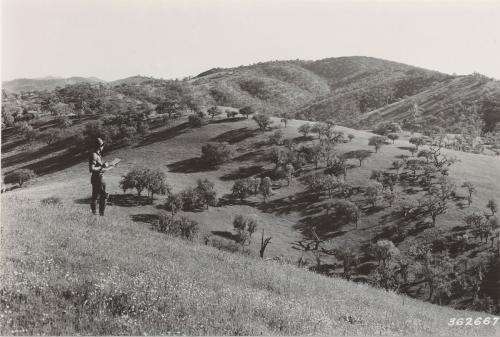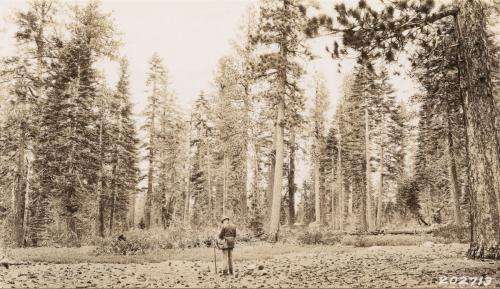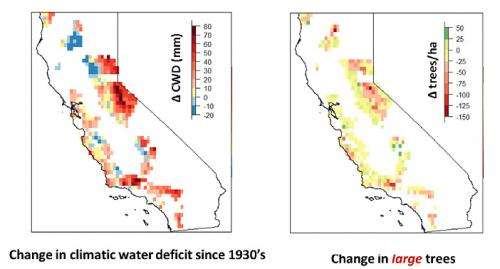January 20, 2015 report
Drought, fire management and land use changes have led to denser forests in California

(Phys.org)—A team of researchers with members from several institutions in the U.S. has found that compared to the beginning of the last century, California's forests are more dense, with fewer large trees, more small growth and are a much bigger risk for fires. In their paper published in Proceedings of the National Academy of Sciences, the researchers describe how they compared forest surveys over the past century and the changes they noted and what it might mean for the future of forest management in the state.
California is notorious for its forest fires—every year, reports of major fires erupting in various parts of the state make headlines, with some suggesting the problem is getting worse. In this new effort, the researchers went back in time to learn what has transpired with the forests in the Golden State to see if such suspicions are correct. They looked at tree census data recorded during the years 1929 to 1936, and compared what they found with similar data from the years 2001 to 2010.
In analyzing the data, the researchers found that large tree density is lower in the more recent years than early last century, for all parts of the state, with some declines as high as 50 percent. In their place are small tree and brush growth, which they found has a much higher density than a hundred years ago. They also noted that over the same period, California has grown drier, as many studies have confirmed. It is the increased water stress, the team suggests, that is at least partly responsible for the change in tree densities. Another factor is fire management. In the past, before people arrived, fires, generally due to lightening strikes would start, and burn thousands of acres before dying natural deaths. That would allow for new growth, which would eventually lead to tall tree growth. Now, whenever a fire starts, it is put out as quickly as possible to protect homes and businesses in the area. The result is highly dense forests with dry small trees—the perfect conditions for fires to start and spread very quickly. The researchers also found that oak trees have grown more numerous while pine populations have declined—another result of the drier climate.
The study suggests that California forest managers are likely to be facing some tough decisions in the years ahead as the planet heats up and the state becomes drier.
-

Mixed stands of Jeffrey pine, white fir, and red fir. Lassen County, California. October 1, 1925. Credit: Wieslander Vegetation Type Mapping Collection, Marian Koshland Bioscience and Natural Resources Library, University of California, Berkeley, CA -

Severe water stress (left red) since the 1930s mirrors the decline of large trees (right red) seen throughout the state, from the Sierra Nevada to the Coast Ranges.
More information: Twentieth-century shifts in forest structure in California: Denser forests, smaller trees, and increased dominance of oaks, PNAS, www.pnas.org/cgi/doi/10.1073/pnas.1410186112
Abstract
We document changes in forest structure between historical (1930s) and contemporary (2000s) surveys of California vegetation through comparisons of tree abundance and size across the state and within several ecoregions. Across California, tree density in forested regions increased by 30% between the two time periods, whereas forest biomass in the same regions declined, as indicated by a 19% reduction in basal area. These changes reflect a demographic shift in forest structure: larger trees (>60 cm diameter at breast height) have declined, whereas smaller trees (<30 cm) have increased. Large tree declines were found in all surveyed regions of California, whereas small tree increases were found in every region except the south and central coast. Large tree declines were more severe in areas experiencing greater increases in climatic water deficit since the 1930s, based on a hydrologic model of water balance for historical climates through the 20th century. Forest composition in California in the last century has also shifted toward increased dominance by oaks relative to pines, a pattern consistent with warming and increased water stress, and also with paleohistoric shifts in vegetation in California over the last 150,000 y.
Journal information: Proceedings of the National Academy of Sciences
© 2015 Phys.org



















